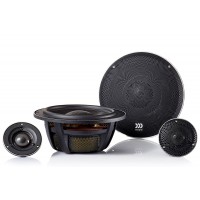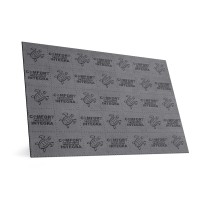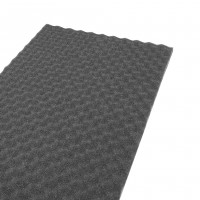Morel Elate Carbon 93A speakers
More about the product
- Use our consulting room
- You can return the goods to us within 14 days
- Try the product at our store
Introducing the Morel Elate Carbon 93A speakers
The Elate Carbon shares most of its high-end components with its Elate Carbon Pro siblings, yet takes a slightly more sensible approach. These two-way and three-way systems have been designed for those who want maximum performance but are looking for a discreet tweeter. The MT450 tweeter's compact design allows users to place the speaker in most production locations or confined spaces using the included plastic brackets. The MT450 tweeter may be smaller in size, but its Acuflex-coated silk diaphragm, open-cavity system and dual neodymium magnet motor give it amazing detail and a silky-smooth, flat frequency response.
All Elate Carbon 3-way systems receive a brand new MM3 3.5″ center speaker. This small mid-range speaker utilizes the best of Morel technology, including an EVC motor, a high-performance 2.1” voice coil and a highly damped carbon fiber / Rohacell diaphragm, allowing it to play with a lower frequency and better control than most 4.5 ” speakers. It handles serious music much better. These attributes drastically improve system performance and allow the speaker to fit into most factory placements.
Elate Carbon wouldn't be complete without exerting its power. Whether you choose a 5.25” / 6.5” or 9” system, each of the woofers features Kliple-optimized EVC motors with 3" diameter voice coils and carbon fiber / Rohacell sandwich diaphragms for extremely low distortion and high level processing energy.The extensive feature set and design of the new Elate Carbon system can exceed your every expectation.
Titanium voice coil
The coil material affects the acoustic parameters of the speaker, its performance management and the quality of the reproduced sound. By using a titanium coil, Morel wanted to increase the mechanical factor (QMS) to allow a wider choice of case types and sizes. In terms of sound quality, a significantly "sharper" sound can be discerned compared to an equivalent aluminum voice coil speaker. The stiff characteristics of titanium, along with its other advantages, create a system that is tonally balanced and accurate, with exceptionally fast transient response.
EVC™ system
Morel speakers with EVC™ technology use voice coils that are up to three times larger than conventional speakers. The EVC™ design moves the magnetic drive system inside the voice coil and eliminates stray magnetic flux by effectively directing all magnetic energy into the voice coil. The result is an ultra efficient and powerful system that is highly compact with efficient heat dissipation and reduced membrane breakdown for less distortion.
DMM motor - 2 magnet system
Morel's dual drive system generates more magnetic energy than a single magnet of similar size, increasing efficiency and dynamic range. The position of the secondary magnet mounted above the top plate in the motor is key to controlling the diffuse magnetic flux, creating a more focused magnetic field while contributing to the speakers' "shielded" characteristic.
Handmade Morel Acuflex membranes
A specially developed damping compound applied to the soft domes of specific Morel tweeters and midrange speakers. The combination of silk and paper materials creates a membrane that exhibits controlled decay cancellation (flexion, to be exact), meaning that each decay mode is suppressed by another in the opposite direction. This cancellation of decay modes leaves nothing but the clean and natural sound that Morel tweeters and midrange speakers are known for.
CAR filter - acoustic cooling
CAR is controlled acoustic resistance. In most automotive applications, loudspeakers are installed in a virtual space such as a door to ensure minimal acoustic load. The CAR Filter™ improves the acoustic load by controlling the airflow inside the speaker, resulting in improved power control by up to 30%. This provides more control over the movement of the diaphragm for better bass dynamics.
Morel Lotus luxury grid
Morel's new Lotus-branded grille has a specific pattern of holes in different shapes and diameters designed to minimize the "horn" effect (a high-frequency peak caused by the resonant frequency of multiple holes of the same size). Innovative metal processing has allowed the construction of a very thin and almost transparent grille that hardly affects the sound when reproducing all frequencies, while maintaining structural integrity to protect the speaker membrane.
| Catalog number | ELATE CARBON 93A |
| Brand | Morel |
| Links | Official web presentation |
| Speaker typeCoaxial speakers: Coaxial speakers are characterized by a so-called all-in-one design. The tweeter and mid-bass speaker are in one basket. The advantage is simpler assembly, but thanks to the connection or proximity of the bands in one speaker, the sound quality will usually be reduced. As a rule, in the middle of the mid-bass speaker, there is a tweeter whose voice coil works in the second air gap of the common magnetic circuit. The three-way coaxial speaker consists of a mid-bass speaker, a center speaker and a separate tweeter in the front on a special beam. Component Speakers: Component speakers are characterized by a division into individual frequency bands, treble + mid-bass + or. bass band. The individual speakers can be placed completely separately, which results in a better sound and acoustic performance. In the vast majority of cases of component speakers, an external crossover is also supplied, which divides the treble, middle / mid-bass, and into the three-band the bass band or allows setting the decibel level of the tweeter (e.g. +2 dB, 0 dB, -2 dB), steepness (e.g. 6dB/Oct. 12dB/Oct.) or active or bi-amp connection. | Component 3-band |
| RMS powerRMS speaker power is the constant power of the entire system, not just one speaker or one side. This is also the performance of continuous use of the speakers. If the RMS power is exceeded for a long time, the speakers may be irreversibly damaged! | 200 W |
| Max. (maximum performancePeak performance , which the speaker can play for a moment (approx. 0.5 s), for example when hitting drums in a song. If the max power is exceeded, the speakers will usually be damaged! | 1000W |
| Sensitivity (SPL 2.83V/1m)Sensitivity, sensitivity or efficiency of the speaker. Speaker sensitivity is given in decibels (dB) and simply put, the higher the value, the lower the demands on the amplifier's power. This is a defacto rating of how a speaker converts watts to sound. Sensitivity ratings are in noise level measured at 1 meter from the speaker using 1 W (watt of power) or using 2.83 volts at the source at 1 meter. A higher decibel level means the speaker is louder with less power. For every 3 dB increase in sensitivity, the speaker requires half the power to reproduce the same volume. For example, if an 88 dB speaker needs 100 Watts to produce a certain volume, then a speaker with a sensitivity of 91 dB needs only 50 Watts to reach the same volume. | 89 dB |
| ImpedanceImpedance - measurement of electrical resistance. When buying speakers, it is important to make sure that the impedance matches the amplifier or car stereo you are using. Example: A 2 Ohm speaker cannot be connected to an amplifier that is only stable up to 4 Ohms! A 4 Ohm speaker can easily be used with an amplifier that is stable up to 2 Ohms. The most common speaker impedance today is 3 - 4 Ohm. | 4 Ω |
| Frequency rangeThe ability of the speakers to play a signal from the lowest frequency to the highest, or the speaker's ability to faithfully reproduce sound in a specific frequency band. Professionally: In the frequency range from 40 to 16,000 Hz, the vast majority of fundamental and overtones (harmonics) of all musical instruments are found. We are interested in the course of the radiated sound pressure in this range of frequencies when the loudspeaker system is supplied with constant power. We call this course the frequency characteristic, which tells us the level of radiated sound pressure in decibels (dB) depending on the frequency. The frequency characteristic of a speaker or speaker system can be expressed most succinctly with a graph. Mostly, however, the frequency characteristic is indicated by indicating the maximum tolerance of the sound pressure in the given frequency range, e.g. 50 to 15,000 Hz -+ 6 dB. Since the frequency characteristics of loudspeakers and systems in general are quite uneven, some manufacturers do not even specify this maximum tolerance of sound pressure in decibels in their catalogs for reasons of prestige. Data impoverished in this way is unfortunately worthless. What is valid is that the manufacturer offers a speaker system with a frequency range of 30 to 20,000 Hz, if he is worried about stating the maximum unevenness of the sound pressure in this range, because he can have a tolerance of, for example, +- 20 dB. The unevenness or undulation of the frequency curve in good speaker systems for high-quality music performance should not exceed +-3 dB in the 80 to 12,000 Hz band and +-6 dB in the 40 to 16,000 Hz band. Greater unevenness already depletes or emphasizes certain tonal areas, which can cause audible or even disturbing distortion. The proportion between fundamental tones and higher harmonics also changes, thereby changing the color of the sound, and individual musical instruments as well as the entire musical image sound unnatural. | 25 - 25000 Hz |
| The diameter of the mid-bass speakerWe state the diameter of the speaker as the diameter of the entire speaker, not including the mounts, when smaller speakers (87, 100, 130 mm) have extra mounts. Some speakers are oval and there the dimension is given in inches, always the shortest side to the longest side. One inch is approx. 2.5 cm. | 220 mm |
| Installation depth of the mid-bass speakerThe installation depth of the speaker is measured from the bottom edge of the magnet to the bottom edge of the tin, plastic or cast speaker basket, or speaker bearing surfaces. | 71 mm |
| Mid-woofer diaphragm materialThe material that was used for the speaker diaphragm. Don't be afraid of the paper, it surprisingly has a very natural and high-quality sound and, thanks to the surface treatment, it can withstand moisture without any problems. | Carbon fiber |
| Center speaker diameterThe diameter of the center speaker is given as the diameter of a round speaker, not including the mount, where the mounts protrude even more on smaller speakers. | 83 mm |
| Mounting depth of the center speakerThe mounting depth of the center speaker is measured from the bottom edge of the magnet to the bottom edge of the tin, plastic or cast speaker basket. | 38 mm |
| Center speaker diaphragm materialDiaphragm material that was used in the manufacture of the center speakers. | Carbon fiber |
| Tweeter dome diameterThe net diameter of the dome (diaphragm) of the tweeter. | 28 mm |
| Tweeter dome materialThe shell material that was used in the manufacture of the tweeter. | Acuflex coated silk |
| Frequency crossover included in the packageThe crossover is an important part of defacto all loudspeakers. A crossover usually contains different resistor values, coil sizes, and capacitor types that fundamentally modify the sound. We describe below what the turnouts are for. Component Speakers: A crossover is part of every quality component speaker system. Its task is to ensure the distribution of frequencies that the amplifier produces in the entire acoustic spectrum of frequencies so that each of the speakers receives only that part of the band that it can optimally play in terms of efficiency and minimal distortion. Coaxial speakers: In most cases, coaxial loudspeakers have a simple crossover (6dB/Oct.) formed by a capacitor at the tweeter. | No |
| Cover grids included in the packageOriginal cover grilles in speaker packaging. | Yes |
| Price forIf the price is for a pair, the package always includes 2 pieces of everything, e.g. 2x mid-bass, 2x tweeter and 2x crossover. | Few |



































